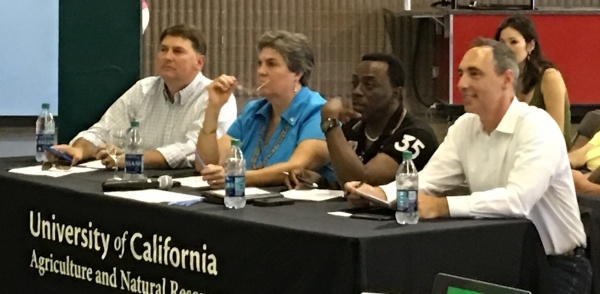I had a great time at last week's three-day Apps-for-Ag hackathon, which was hosted by ANR, the California State Fair, and the City of Sacramento. Although I've participated in an open science CodeFest before at NCEAS, this was my first time at a competitive hackathon where teams compete for cash prizes and start-up support. On the first day, we heard about some of the key challenges facing agriculture in California, including Asian Citrus Psyllid (ACP), and how technology may be able play a role in addressing those challenges. Some participants also came with their own challenges, and spoke about those.
The organizers of the hackathon did an amazing job assembling a great pool of resource persons, including Bobby Jones the Chief Data Officer from USDA, two representatives from Amazon Web Services who brought a couple of Internet-of-Things starter kits, Neil McRoberts who is an expert on ACP, and several veterans of previous hackathons.
In the end, four teams formed, and in less than 48 hours developed their ideas into a product and presented their work to a panel of judges at the State Fair. All four teams choose to develop an app for a mobile device, although the hackathon guidelines would have allowed other outputs including websites or desktop tools. It was interesting to watch the projects evolve from the broad sketches teams discussed on Friday, to final products on Sunday. The presentations often included marketing plans, existing product research, monetization strategies, etc. I was struck how online spatial databases and visualization were central to all of the apps developed. The judges questioned the teams about both technical and practical issues, including the economic viability of some of business models, policy issues including privacy, and bandwidth requirements. A description of the award winning apps can be found here.

Judges at the Apps for Ag Hackathon: Rob Trice, Glenda Humiston, Bobby Jones, and Tom Andriola
I came away from the hackathon with a few impressions. First, although the technology stack each team adopted varied, they all integrated spatial databases from the cloud with geolocation services on mobile devices. Half of the teams also used sensors connected to the Internet, and half sought to foster online communities. The diversity of applications developed demonstrates the power of this suite of tools to meet an enormous number of opportunities in agriculture and natural resource management.
Second, although hackathons have been known to produce wildly successful apps and even start-ups, I suspect the most significant and enduring outcome of many hackathons may not be the apps themselves, but the connections made, the knowledge shared, and the resources mobilized (i.e., people, data, & tools). Not only did everyone who participated meet some new people, the nature of the challenges required groups with diverse skillsets to work together. All of the challenges needed the skills of developers, designers, domain specialists, and business development experts. No one has all these skills, but everyone came away with a little more appreciation of the diversity of roles needed for a successful project, and a little more experience communicating across fields. We also all learned some new things about agriculture and technology, as well as available resources out there from datasets to hardware to cloud based computational platforms.
Finally, the spirit of entrepreneurialism was very real, acting like a high-octane fuel that powers engines of creativity and rapid development. The prize money, the competitive spirit, the rules of contest, and the alluring possibility of perhaps establishing a successful start-up were clearly incentives that gave teams the extra energy to work late into the night. However it also occurred to me that the hackathon spirit may also act as a filter on what can be achieved in a hackathon. Not all important problems can be digested in such a short period, and not all technology solutions to important problems are easily monetizable, which is one of the criteria hackathon teams may use to select projects. To tackle complex challenges like ACP, domain specialists could perhaps scope out the technology needs in greater detail before the hackathon, organizers could incentivize teams to work on those challenges, and conference calls could be pre-arranged with targeted end-users who may be a small set of scientists or managers.
The Apps-for-Ag hackathon series is a great collaboration between the ag industry, technology companies, government agencies at all levels, and academic institutions like ANR. I can't wait to see what see what challenges will be tackled next time.